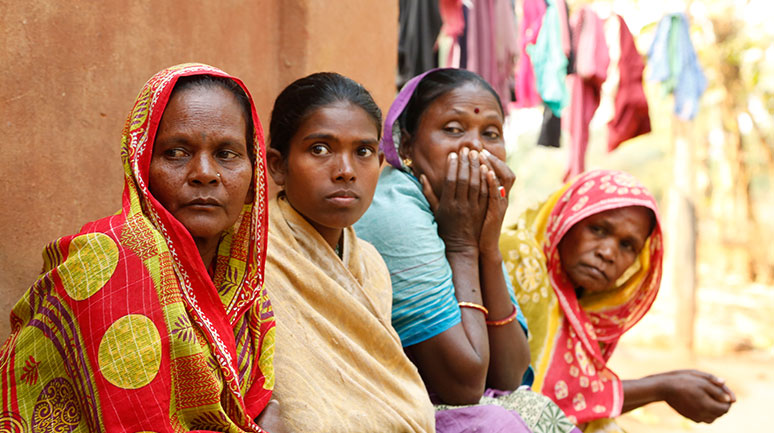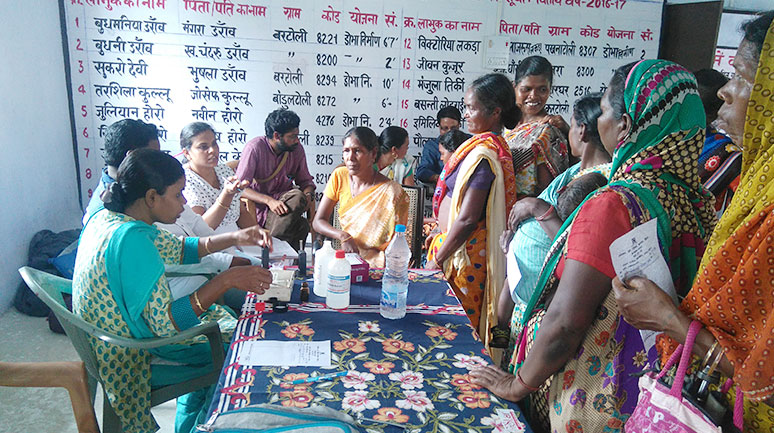Women and Anaemia


Calling for a concerted effort by civil society organizations to address the alarming reality of anaemia in rural women between 14 and 49 years of age, this article focuses on the necessity to improve personal and individual lives, an aspect that has so far been ignored in the endeavour to bring about financial stability by enhancing livelihoods
S eema Kullu, carrying her newborn son on her back, waited in the queue to give her blood sample to check her haemoglobin (Hb) level. The result, when it came, was far from satisfactory. The Hb level was 7.0 g/dl, which is a critical anaemic condition.
Seema is a member of the SHG formed by PRADAN—a civil society organization (CSO) working with women’s collectives, to enhance their income through various livelihood interventions. She also earns from working under MGNREGA in Basia block, Gumla district, Jharkhand.
According to a survey conducted by National Family Health Survey (NFHS) in 2005–06, 70.6 per cent of the women between 15 and 49 years in Jharkhand were found to be anaemic. When we presented this data to the women’s collectives that we work with, they decided to conduct a camp in one of the panchayats, where the HB levels of the SHG women and the MGNREGA workers would be tested. The average level of HB across 56 women, who attended the camp, was 8.8g/dl with nobody having a normal Hb level of 12g/dl.
PRADAN has been working with women’s collectives in Gumla for the past 18 years. It has been able to organize collectives that have enabled development and have helped to adopt certain best practices in agriculture, for example, vegetable cultivation, mango plantation, improved paddy, seed treatment and floriculture. Poultry and goat rearing have also been introduced and have become good income- generating activities. The question, however, arises, “Why has there been no substantial improvement in the individual/ personal lives of the women even after PRADAN’s successful intervention in enhancing livelihoods and incomes of the households?
The question, however, arises, “Why has there been no substantial improvement in the individual/ personal lives of the women even after PRADAN’s successful intervention in enhancing livelihoods and incomes of the households?
P RADAN has also worked to introduce backward and forward linkages of this agricultural produce by creating agriculture production clusters (APCs), whereby a relatively large number of families have become involved in common agricultural practice. By creating models for income enhancement through various livelihood interventions and engaging with collectives, PRADAN has helped boost the income of many families.
Lalita Oraon from Palkot says that the mango plantation on half an acre of her land, using PRADAN’s model, has increased her household income by Rs 25,000 every year. This is a significant rise in income. When we talk with the collectives about the impact that they have experienced since they have become a part of an SHG, we usually hear that their management of finances has improved through the savings- and-credit activity that goes within and outside of the SHG. In addition, their incomes have risen through collectively planned agricultural practices with modern techniques. Therefore, from the above experiences, we understand that PRADAN has been successful in working with the collectives to build upon their existing economic activities and to help generate more income. Many families (56.64 per cent) of the 68,042 families that have come into the SHG fold in Gumla that PRADAN has engaged with have benefitted from the intervention.
Lalita and Seema come from similar kind of worlds.

The question, however, arises, “Why has there been no substantial improvement in the individual/ personal lives of the women even after PRADAN’s successful intervention in enhancing livelihoods and incomes of the households?”
The larger goal of PRADAN is to help co-create a just and equitable society. However, at the confluence of class, caste and gender, it is quite evident that women are the most vulnerable, and due to this vulnerability, their pursuit of healthy and dignified living is hampered. The acute condition of anaemia in the women of Jharkhand can very well be associated with the vulnerabilities discussed below.
Seema Kullu lives in Tetra village in Basia block. Her world is very similar to that of the other tribal women of her village. She gets up at 4 a.m. and starts doing household chores such as cleaning, fetching water, cooking food, getting the children ready for school, etc. By the time the morning chores are over, it is already 8 a.m. She then goes to the farm with her husband and works in the field there until noon. She returns and serves food to all the members of the family. In the afternoon, when most of the family members rest, she takes the cattle out for grazing and returns in the evening. After coming back, she starts to prepare dinner and the family eats dinner at around 9 p.m. Seema eats after everyone has finished eating and finally sleeps by 11 p.m.
This is the routine, with minor variances, of most women in the region. They seldom get time for rest or leisure. As a result, taking care of their own health and well-being has never been a high priority. Clearly, the division of work is skewed heavily in favour of men. There are other aspects of the existing social system that further marginalize and oppress women. We have personally heard from a number of women that they are not allowed to eat non-vegetarian food during menstruation whereas during menstruation is when they need more nutrition.
There are other aspects of the existing social system that further marginalize and oppress women. We have personally heard from a number of women that they are not allowed to eat non-vegetarian food during menstruation whereas during menstruation is when they need more nutrition
T here are other aspects of the existing social system that further marginalize and oppress women. We have personally heard from a number of women that they are not allowed to eat non-vegetarian food during menstruation whereas during menstruation is when they need more nutrition.
Patriarchy also contributes to the marginalization of women and limits their access to resources. For instance, Seema does work under MGNREGA, which gives her Rs 168 for one day of labour. Her husband also earns the same amount. However, her husband spends that amount according to his will on items such as alcohol and food, whereas Seema does not. She hardly ever spends her earnings on herself, neither on any material desires nor on her own nutritional needs. Instead, she brings the entire earnings home to be used for the welfare of her family. This particular example is reflective of the fact that patriarchy does not allow a woman to have control over her own income and resources and that she has to constantly compromise her interests and individuality for the larger well- being of the family. The same does not apply to men.
We also see that Seema’s access to the money she earns through livelihood-based activities, by being a member of the SHG, is also minimal. And this is probably the reason that, even after seeing an enhancement in income and mobility, not much has changed in the individual lives of women. Therefore, we see that Seema’s present health condition is an outcome of these social circumstances. The state, civil society and community- based institutions must take cognizance of these conditions of marginalization.
Anita Devi, an auxiliary nurse mid-wife (ANM) in Basia, said that a number of Primary Health Centres (PHCs) remain closed even on working days. ANMs are a focal point through which the government tries to take its healthcare system to the last mile. Given this fact, there are still many vacancies that need to be filled. The department, at the most basic of levels, is heavily understaffed. Health camps, that are to be held on a regular basis, take place intermittently with long gaps. The national guidelines on how to control iron deficiency, or anaemia are:
- To bring to the attention of Programme Managers the serious negative consequences of anaemia for health and physical growth, mental and economic productivity of individuals and populations
- To broadly identify platforms of service delivery and indicate the role of service providers
- To lay out Iron Folic Acid (IFA) supplementation protocols across the lifecycle for the prevention of anaemia
- To define a standard treatment protocol for facility-based management of mild, moderate and severe anaemia, segregated by levels of care
I n a survey conducted by the Model Districts Health Project, Earth Institute, Columbia University, in 2014–15 in Simdega district, Jharkhand, ANMs were assessed for their knowledge of anaemia. Some of the findings of the survey were really pitiable. As many as 64 per cent of the ANMs in the sample had not received any training in the Anaemia Control Programme. When they were given a scenario of a four-month pregnant woman’s HB being 8g/dl, only half of them could identify it as a case of severe anaemia. This underscores that their knowledge on HB levels and types of anaemia is very poor. As long as the state does not show any will to increase the spending, the situation is not likely to change significantly. Therefore, public action and advocacy becomes imperative.
As long as the state does not show any will to increase the spending, the situation is not likely to change significantly. Therefore, public action and advocacy becomes imperative
M ost of the ANMs (81 per cent) did not have any knowledge of the recommended IFA (Iron Folic acid) dose. This lack of awareness greatly impacts their counselling capacity to encourage women to consume IFA. Clearly, ANMs need to be given training on a large scale and improved supervision and staffing are required in order for existing healthcare facilities to be implemented in their entirety and reach those who need it the most.
Problems of infrastructure, human resources and the general capacity of public health systems can also be attributed to the fact that the central government’s spending on health is only one per cent of the nation’s GDP. This suggests that as long as the state does not show any will to increase the spending, the situation is not likely to change significantly.
Therefore, public action and advocacy become imperative.
Looking back at what PRADAN has managed to achieve, therefore, in the time that it has remained engaged with the community, one realizes that there is still a lot to be done.
Keeping the gender, health and nutrition needs in perspective, we need to engage with two major stakeholders—community institutions and the state.
PRADAN needs greater expertise in themes such as gender, health, nutrition, etc.; therefore, tying up with other CSOs that carry a certain capacity in these areas of development will be beneficial. A collaboration of this kind will also help us capacitate our own understanding and the modes of practice around these themes.
Also imperative is the active involvement of academicians, social scientists, researchers, activists, etc. As an outcome of this engagement, the effort will be to see community institutions as agents of change, which can and will trigger a counter culture, so that taboos, myths and other such aspects of their social system that propagate marginalization can be revisited. In case of the latter, CSOs (including PRADAN) can form a pool or a forum, wherein the state’s policies are reviewed and amendments suggested as a part of policy advocacy. This pool of CSOs can also help build the technical capabilities of the state on issues of social concern, including health. Community institutions also need to be strengthened in relation to the state so that they can exert pressure as and when service delivery suffers or any rights to dignified living are violated.
Pushkar Jha and Meraj Uddin are working as Executives in PRADAN and are based in Palkot, Jharkhand.

